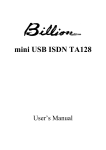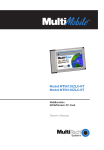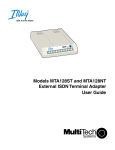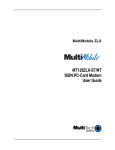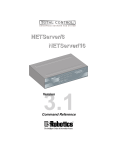Download MRi MRi-ISDNPCI Terminal Adapter
Transcript
ISDN TA PCI Card User Manual INTRODUCTION The ISDN TA PCI Card brings the latest in mobile communication technology with flexibility and convenience. With the wide range ISDN signaling protocols switches supports, mobile experts may enjoy the mobile communication across the world and the high speed digital service. System Requirements Pentium 100 or above At least 30MB free hard disk space At least 16MB RAM Windows 95/98/2000 or Windows NT pre-installed Specifications ISDN standards Basic Rate Access (2B+D) S/T-Interface: Compliant with ITU-T I.430 D-channel: ITU-T Q.921, Q.931 ETSI NET3 B-channel: V.120, V.110, X.75/T.70NL/ISO8208 Async-to-Sync PPP conversion Multilink PPP, 56 K Modem (CAPI only) G3 fax (CAPI only) Voice (CAPI only) Line Rate 64/56 Kbps on 1 B-channel 128/112 Kbps on 2 B-channel (PPP/MP) 64/56Kbps on 1 B-channel 16Kbps on D-channel ISDN Network & Switch Compatibility National ISDN-1 (NI-1) AT&T 5ESS Custom Northen Telecom DMS-100 Custom DSS1 (Euro-ISDN) INS-Net 64 Application Program Interface Supported VCOMM WinISDN CAPI 2.0 NDIS WAN Operating System Supported Windows 95 and OSR2 Windows 98 -1- Windows 2000 Windows NT 4.0 Physical Specifications RJ-45 ISDN line interface -2- INSTALLATION FOR WINDOWS 95/98 1. Remove the chassis cover of your computer. 2. Check the ISDN TA PCI Card to make sure J2 and J3 are open with no jumper caps cover. 3. Align the contact edge of the ISDN TA PCI Card toward the connector of any free PCI Bus Master expansion slot. Push firmly and slowly until it is fully seated in the connector. 4. Screw the PCI card to the computer chassis with the provided screws. 5. Replace the computer’s chassis cover. 6. Turn on your computer. 7. Start Windows 95/98. Windows 95/98 will automatically detect the new device. 8. Insert the device driver disk into your floppy disk drive as the following command dialog box appears. . 9. The installation program will proceed automatically. 10. When the following dialog box appears, click Finish. -3- 11. When the following dialog box appears, select “Yes, I am finished installing devices.”, and click Next. 12. Click Finish when the following dialog box appears. And you are finished installing the PCI ISDN TA Card into your computer. -4- INSTALLATION FOR WINDOWS 2000 1. Install the ISDN TA PCI Card as the procedures described in the previous section (Windows 95/98) and restart your computer. Windows 2000 will automatically detect the new network device. 2. Click Next to proceed. 3. Select Search for a suitable driver for my device (recommended) and click Next. 4. Load the network device driver disc into the CD-ROM disc drive of your system. Select Specify a location and click Next. Windows will start searching for the appropriate driver files for the software installation. -5- 5. Make sure that the file path is correct and click OK. 6. The appropriate driver files of the network device is found. Click Next to install. 7. Click Finish to continue. -6- 8. Once you click Finish, Windows will automatically detect another driver of the network device. 9. Click Yes when the following dialogue box appears. 10. Select the appropriate switch type in Windows 2000 and click Next.. 11. Click Next. -7- 12. Once you click Next, Windows will automatically detect the network device driver again. 13. Click Yes to continue. 14. To verify if the Network device exists in your computer and is enabled, go to My ComputerÆControl PanelÆSystem. Click the Device Manager tab. If the Intelligent PCI ISDN TA(ISDN) device, Modems, Multifunction adapters and Network adapters are found, it means that your Network device is well installed and enabled. If not, consult your computer dealer for technical support. -8- UNINSTALLATION (WINDOWS 2000) Removing the Device Driver 1. Go to My ComputerÆControl PanelÆSystem. 2. From the System window, click the Hardware tab. 3. From the Hardware tab, double click the Device Manager button. 4. From the Device Manager window, click Multifunction adapters to expand. Right-click Intelligent PCI ISDN TA Multi-Functions. 5. Choose Uninstall and click OK. The software of this device will be removed automatically. Removing the Applications 1. Go to My ComputerÆControl Panel. 2. From the Control Panel window, double click the Add/Remove Programs icon. 3. Choose Configuration Utility for Windows 2000. Click Change/Remove button and click OK. The applications for this device will be removed automatically. 4. Remove the ISDN TA PCI Card from your computer. -9- FIRST THING TO KNOW ABOUT SOFTWARE INSTALLATION The ISDN TA PCI Card is designed to support a wide bandwidth of interfaces/drivers for a total solution in different environments. The software setup procedures accordingly vary from interfaces/drivers to interfaces/drivers. To help you set up the software efficiently, the software installation is organized by interfaces under Windows 95/98/2000 and Windows NT respectively. The following figures are illustrated as guideline-like flow charts. If something goes wrong, track down the flow to check if there is any procedure missing while setting up; and move to the corresponding section for details. W indows 95/98/2000 Hyper Terminal DUN VCOMM CAPI NDIS RVS-COM Center VCOMM Port Driver * PPP * V.110 * V.120 CAPI 2.0 Interface * PPP * V.110 * V.120 * X.75 * Modem * Eurofile Transfer * G3 FA X over ISDN NDIS Por t Driver * PPP ISDN Low Level Driver The blocked area indicate that after when setup.exe has been executed (see section titled “Installing Device Driver”), the Phone Dialer VCOMM Port driver, CAPI 2.0 and the ISDN Low Level Driver were also installed. You may then use Phone Dialer or the functions with VCOMM directly. For CAPI mode, however, it is required to install RVS.COM Center beforehand to enable the functions with CAPI. For NDIS mode, unless the NDIS Port Driver has been installed, the ISDN Low level Driver won’t be able to work. - 10 - W indows NT Hyper Terminal DUN CAPI NDIS RVS-COM Center CAPI 2.0 Interface * PPP * Modem over ISDN * G3 Fax * Voice application NDIS Por t Driver * PPP ISDN Low Level Driver The blocked area indicate that after when setup.exe has been executed (see section titled “Installing Device Driver”), the Phone Dialer CAPI mode and NDIS were also installed. You may then use Phone Dialer or the functions with NDIS mode directly. For CAPI mode, however, it is required to install RVS.COM Center beforehand to enable the functions with CAPI. - 11 - SOFTWARE INSTALLATION FOR WINDOWS 95/98/2000 Installing the Device Driver 1. Insert the device driver compact disc or disks by sequence into your computer. 2. Double-click My Computer. 3. Double-click the drive whichever contains the device driver. For example, if you are using disks, insert the disks into drive A, double-click “3½ Floppy (A:)”. Or if you are using compact disc, select the CD-ROM drive and double-click folder Win9x when in Windows 95/98, or Win2000 for Windows 2000. 4. Double-click Setup.exe. Follow the on-screen instruction to proceed. Installing The Application Programs Before you start, make sure the type of your Application Program Interface. The Application Program Interface (API) is used as the interface between the hardware (ISDN TA PCI Card) and the application programs. Before performing the installation, make sure the type of API matching your system. The currently supported APIs are VCOMM, NDIS, and CAPI. Move to the specific section titled the appropriate API for your need for installation. VCOMM Mode COM port is commonly used for connecting to the external ISDN devices. With the VCOMM COM port emulation, the ISDN multifunction PCI Card works exactly like an ISDN TA (Terminal Adapter) external box, which can run with traditional terminal program packages, such as Windows 95 Hyper Terminal, Procom Plus for Windows, Telix, pcAnywhere, etc., to hook up to the on-line services and bulletin boards. In this mode, ISDN AT commands are usually used to drive the ISDN multifunction PCI Card. Making PPP Connection (Basic Internet) 1. Go to My Computer. 2. Select Dial-Up Networking. Double-click Make a New Connection, a dialogue box will appear as shown below. 3. Name the new connection appropriately. 4. Select Intelligent PCI ISDN TA (modem). 5. Enter in the area code and phone number of your Internet Service Provider (ISP). Leave out the ‘-‘. (Example: ‘1234567’ NOT ‘123-4567’ ) Typically, the country and area codes are not required and should be disabled. - 12 - 6. From the Dial-Up Networking window right-click your newly created connection. Select Properties. On the General tab, cancel the selection of “Use area code and Dialing Properties” and click OK. 7. From the Start menu, select Programs. Select Configuration Utility. Click Config. A dialogue box will prompt you to change the settings to fit your needs. 8. Select the proper switch type corresponding to your need. Switch Type varies between countries. Although you have the option of “Automatic” as a selection, it is highly recommended that you chose a specific selection, to reduce the chance of incompatibility. Typically the selections are as follows: 9. Areas Switch Types Canada & United States Northern Telecom & NI-1 Japan INS Net 64 Taiwan DSS1 (ETSI) Europe DSS1 (ETSI) Enter the ISDN phone numbers and the Service Profile Identifier. Number (SPID) will be supplied by your local ISDN telephone company. [NOTE: With the “INS Net 64” & "DSS1 (ETSI)” switch types, there are no SPID’s to be entered.] 10. Now you are ready to connect the ISDN TA PCI Card to your system. Refer to the Hardware Installation section for details. Making Multilink PPP Connections The Intelligent ISDN TA PCI Card supports the combining of two 64 Kbps data channels into the equivalent of a single 128 Kbps line, which is known as Multi-Link connection. To make the multilink PPP connections, firstly the PPP connection has to be completed, and the hardware (the ISDN TA PCI Card) has been properly installed. Perform the following steps to proceed. 1. Go to the Start menu. Point to Program. Select Configuration Utility. Execute CONFIG. 2. Open “General” tab. Click “MP Enabled” in “PPP Setting”. - 13 - 3. Apply the other settings, “BOD Enabled” and “Second Phone No.” if available. Making V.110 Connections 1. Execute “Config” in Configuration Utility. 2. Select the COM Port Setting tab. Select “V.110” for “B-Channel protocol” in “1st COM port setting”. 3. Make sure Dial-Up Networking is well installed. 4. Double-click “Make New Connection”. 5. Name the new connection appropriately. For example, “V.110”. 6. Select “Intelligent PCI ISDN TA (modem)” in the “Select a device” box. 7. Click Configure, and specify the V.110 user rate in the Maximum speed box. Click Next. Maximum speed=1200 V.110 user rate = 1200 bps. Maximum speed=2400 V.110 user rate = 2400 bps. Maximum speed=4800 V.110 user rate = 4800 bps. Maximum speed=9600 V.110 user rate = 9600 bps. Maximum speed=19200 V.110 user rate = 19200 bps. Maximum speed=38400 V.110 user rate = 38400 bps. Maximum speed=57600 V.110 user rate = 57600 bps* * Available only for Japan If the maximum speed you selected is not listed above, the system will automatically adapt the V.110 user rate to the default setting at 38400 bps. 8. Enter the ISDN phone number of the remote party that you want to call. 9. Click “Next”, and click “Finish” to complete the setting. Making V.120 Connections 1. Execute “Config” in “Configuration Utility”. 2. Select COM Port Setting tab. Select “V.120” for “B-Channel protocol” in “1st COM port setting”. 3. Go to My Computer. Make sure “Dial-Up Networking” (DUN) is well installed. 4. Double-click Make New Connection. 5. Name the new connection appropriately. For example, “V.120”. 6. Select “Intelligent PCI ISDN TA (modem)” in the “Select a device” box. 7. Click “Configure” button, and give the appropriate settings. Ignore the “Maximum speed” setting (but you are still recommended to set to the speed at higher than 64000 bps, such as 115200 or higher). Click “Next”. 8. Enter the ISDN phone number of the remote party that you want to call. 9. Click “Next”, and click “Finish” to complete the setting. Making Multi-destination Connections The Intelligent ISDN TA PCI Card enables the connections between the different destinations with two different protocols at the same time. For example, you can separately and independently use one ISDN BChannel (say B1-Channel) with PPP protocol to connect to ISP, and the other B-Channel (say B2-Channel) with V.110 or V.120 to connect to the corporate network in head quarter or branches. This feature lets the ISDN TA PCI Card fully utilize the ISDN two B-Channel resources. 1. Set up the PPP connection for the first application. Refer to the “PPP Connection (method 1)” section for setting details. 2. Set up the second application, for example, V.120: (a) Add the 2nd COM port. Enter “Control Panel” Æ “Modem”. Click “Add” button. Check “Other”. Click “Next”. - 14 - Check “Don’t detect my modem; I will select it from a list”. Click “Next”. Select “Intelligent ISDN” in “Manufacturers”, and “Intelligent PCI ISDN TA (modem)” in “Models”. Click “Next”. Select “ISDN_2nd_COM”. Click “Next”. Click “Finish”. Now you can find “Intelligent PCI ISDN TA (modem) #2” in “Control Panel” Æ “Modem”. (b) Follow the steps in “V.120 Connection” section. Select “Intelligent PCI ISDN TA (modem) #2” for V.120 connection setting at step (6). (c) Finish the other steps to complete the V.120 connection settings. - 15 - CAPI Mode Before starting any applications in CAPI mode, the RVS-COM “CommCenter” is required to be executed. If the RVS.COM is not yet installed on your computer, perform the following procedures. Installing RVS.COM Lite 1. Insert the RVS-COM compact disc into your CD-ROM drive. Press Yes when the opening screen appears. 2. Follow the on-screen instruction to proceed. 3. When finished, the installation program will restart your computer. When your computer is restarted, the following screen will appear. 4. Click Express configuration main line>. Follow the on-screen instruction to finish the installation. 5. To make sure if the RVS-COM has been well installed, you may check by going to the Start menu>Settings->Control Panel->Modems to see if “RVS ISDN Internet PPP” exists in there as illustrated below. - 16 - Making PPP connections 1. Execute RVSCommCenter”. 2. Click “Make new Connection” in the Dial-Up Networking folder. Name the new connection appropriately, for example, “RVS_PPP”. Select “RVS ISDN Internet PPP”. 3. Click Configure…. Select “RVS Port (COM#)”. Click OK. 4. Click Next. Enter the ISDN phone number of your ISP. Click Next. 5. Click “Finish”. Now you are ready for Internet access through CAPI. Making Multilink PPP Connections There are two ways to setup the ISDN PCI Card for Multilink PPP (MP or MLP) connections through CAPI mode. - 17 - Method 1 1. Execute RVSCommCenter. 2. Complete the PPP connection setup in the previous section. 3. Execute Config. (Start->Programs->Configuration Utility). 4. Open the General tab. Click “MP Enabled” in “PPP Setting”. Apply the other settings, “BOD Enabled” and “Second Phone No.” if available. 5. Now you are ready for Internet access. Method 2 1. Execute RVSCommCenter”. Click the Service tab. 2. When the above dialog box appear, check 2nd COM port and click OK. 3. Go to My computer. Select Control Panel. Double-click Modem. Click Add. 4. Select “Other Modem”. Click “Next”. 5. Select “Don't detect my modem; I will select it from a list”. Click Next. 6. Select “RVS Datentechnik” – “RVS ISDN Internet PPP”. Click Next. - 18 - 7. Select the RVS COM ISDN port that you just added. Click Next. 8. Click “Finish”. 9. Now you can see “RVS ISDN Internet PPP #2” in the modem list in “Control Panel” Æ “Modem”. 10. Enter “Dial-Up Networking” folder in My Computer. 11. Click “Make new Connection”, and name the new connection appropriately. For example, “RVS_MP”. Select the modem “RVS ISDN Internet PPP”. Click Next. - 19 - 12. Enter the ISDN phone number your ISDN ISP. Click Next to finish. 13. Right-click the new connection in Dial-Up Network. Click Property. 14. Click the “Multilink” tab. Check “Use additional device”. Click Add. Select RVS ISDN Internet PPP #2”. Click OK to complete the Multilink PPP settings. Making V.110 Connections 1. Execute “CommCenter”. And make sure all the settings are well and correctly configured. 2. Go to My Computer. Make sure Dial-Up Networking (DUN) is well installed. 3. Double-click “Make New Connection”. 4. Name the new connection appropriately. For example, “RVS_V.110”. 5. Select “RVS ISDN V.110” in “Select a device” box. 6. Click “Configure” button, and specify the V.110 user rate in “Maximum speed” box. Click “Next”. Maximum speed=1200 V.110 user rate = 1200 bps. Maximum speed=2400 V.110 user rate = 2400 bps. Maximum speed=4800 V.110 user rate = 4800 bps. Maximum speed=9600 V.110 user rate = 9600 bps. Maximum speed=19200 V.110 user rate = 19200 bps. Maximum speed=38400 V.110 user rate = 38400 bps. Maximum speed=57600 V.110 user rate = 57600 bps* * Available only for Japan - 20 - If the maximum speed you selected is not in the above list, the automatically adapt the V.110 user rate to the default setting at 38400 bps. 7. Enter the ISDN phone number of the remote party that you want to call. 8. Click “Next”, and click “Finish” to complete the setting. system will Making V.120 Connections 1. Execute “CommCenter”. And make sure all the settings are well and correctly configured. 2. Double-click “Make New Connection”. 3. Name the new connection appropriately. For example, “V.120”. 4. Select “RVS ISDN V.120” in the “Select a device” box. 5. Click “Configure” button, and give the appropriate settings. Ignore the “Maximum speed” setting (you are recommended to set to the speed at higher than 64000 bps, such as 115200 or higher). Click “Next”. 6. Click “Next”. 7. Enter the ISDN phone number of the remote party that you want to call. 8. Click “Next”, and click “Finish” to complete the setting. Making X.75 Connections 1. Execute “CommCenter”. And make sure all the settings in the tab are well and correctly configured. 2. Enter “Control Panel” Æ “Modems”. Select “RVS ISDN X.75 transparent”. Click button. Make sure the COM port setting is correctly assigned. 3. Run Windows 95 “Hypertrm”. Name the new connection appropriately. For example, “RVS_X75”. Click “OK”. 4. Enter the ISDN phone number that you want to connect to. 5. Select “RVS ISDN X.75 transparent” in “Connect using” box. Click “OK”. 6. Click “Dial” button to make dialing. “Proprieties” After establish the ISDN link, you can use the data transmission protocol, such as Z-modem or X-modem, for data transfer. For servers which support X.75 T.70NL protocol, you have to choose “RVS ISDN X.75 T.70NL” in the above setup steps. EuroFile Transfer Applications 1. Start RVS CommCenter. If your are to act as an answering party (host mode), check Accept calls, otherwise disselect this box to act as the calling party. Check Eurofile transfer. 2. Start the RVS TransferMaster. The New Connection dialog appears. - 21 - 3. Select, by opening the list of the field Name, another party that has already been saved, or enter a Name for a new other party. Enter the Phone number of the other party and check Other party uses ISDN Eurofile transfer. Click Next. 4. Enter the details for the connection in the Connect To dialog box. Click Connect. 5. The connection will be established and you will then see the folder that the other party has made available to you for access. Use Drag & Drop or the Clipboard (Copy / Paste) to transfer files between Explorer windows or the Desktop on your PC and the folder on the other party's PC, and vice versa. Access any subfolders on the remote PC by double-clicking on the symbols. To disconnect, select Disconnect from the Connection menu, or click the Disconnect symbol. 6. If you have entered new connection data you are prompted to save the connection data when you Exit RVS TransferMaster. The new other party is then added to the selection list of the field Name in the dialog box New Connection. Making “Modem over ISDN” Connections Using RVS-COM Softmodem 1. Start RVSCommCenter. 2. Open Softmodem tab. Check Use Softmodem. Click OK. - 22 - 3. Open the ISDN tab. Select appropriate ISDN voice encoding scheme for your location. Generally, you should select “A-law” for European countries, and “Mu-law” for N. America. 4. Run “Config” in “Configuration Utility”. 5. Open “Switch type” tab. Choose appropriate “Voice Encoding” scheme. Now you are ready to use the RVS-COM’s Softmodem function. Refer to the RVS-COM on-line documentation for application details. Making G3 Fax over ISDN 1. Start CommCenter. 2. Open the SoftwareFax tab. Select “Use SoftwareFax to receive fax” to receive a fax. Or select “Use SoftwareFax to send fax” to send a fax. 3. Open “ISDN” tab. Select appropriate ISDN voice encoding scheme for your location. Generally, you should select “A-law” for European countries, “Mu-law” for North America - 23 - 4. Open the Service tab. Select Accept calls. Select Fax. Click OK. Sending a fax 1. Start Create New Fax in the RVS-COM group programs. Click OK. 1. Follow the on-screen instruction to enter the necessary information. When all set, RVS will send out the fax for you automatically. - 24 - Receiving a fax 1. Wait for incoming fax calls. 2. You can go to Inbox to read the incoming fax. Voice Applications The voice applications included are: 1. Digital answering machine 2. ISDN Phone (acts like a telephone set, that you can communicate with the remote parties over ISDN line) To fully use the voice applications, especially the ISDN Phone service, a full-duplex audio device (sound card) is required. Full-duplex means, that your audio device can handle incoming and outgoing sound signals simultaneously (i.e. you can listen and talk at the same time). If you do not have full-duplex, then you can only hear from the caller. However, this will still let you run the answering machine function. Digital Answering Machine 1. Start RVSCommCenter. 2. Open the Service tab. Check Accept calls. Check Answerphone. 3. Open the ISDN tab, select the appropriate ISDN voice coding scheme for your location. A-law is usually used in European countries, and Mu-law for North America. 4. Make sure all the other settings in “RVS CommCenter” are correctly configured. Click Ok. - 25 - 5. Run “Config” in “Configuration Utility”. 6. Open “Switch type”. Choose appropriate “Voice Encoding” scheme. The setting should be consistent with RVS-COM in step (3). Perform the following steps to record Voice recording 1. Start Telephone in RVS-COM program group. Click the Answerphone function bar to toggle to the ON state. (for the OFF state is for ISDN Phone utility.) 2. Click Settings to record/edit your greeting message. The incoming voice message will be stored in “Inbox”. Double-click the received voice mails to play back the messages. ISDN Phone 1. Start RVS-COM “CommCenter”. 2. Open the Service tab. Clear the selections of the Accept calls and the Answerphone check box. 3. Open the ISDN tab, select the appropriate ISDN voice coding scheme for your location. A-law is generally used in European countries, and Mu-law for North America. 4. Make sure all the other settings in “CommCenter” are correctly configured. Click OK. 5. Run “Config” in “Configuration Utility”. 6. Open “Switch type”. Choose appropriate “Voice Encoding” scheme. The setting should be consistent with RVS-COM in step (3). 7. Start Telephone in “RVS-COM Lite” program group. 8. Click “Answerphone” function bar to the OFF state (for the ON state is for “Answering machine” services). 9. Connect the microphone and speakerphone to the audio interface(s) on your laptop. When the calls come in, the “RVS Phone” will appear automatically. Click Accept button to pick up the calls. When finished, click “Hang Up” to end the connections. - 26 - NDIS Mode NDIS is dedicatedly designed for Internet connections with Microsoft ISDN Accelerator Pack. Perform the following steps to install the NDIS driver,. 1. Make sure ISDN Accelerator Pack is pre-installed, and the PCI Card is firmly seated. 2. Go to Control Panel. Select Add New Hardware. Click Next. 3. Select “No” for “Do you want Windows to search for your new hardware”. Click “Next”. 4. Select “Network adapters” in “Hardware types” list. Click “Next”. 5. Select “Intelligent” in “Manufacturers”, and “Intelligent PCI ISDN TA (Net)” in “Models”. Click “OK”. 6. Click “Finish”. 7. Click “Next”. 8. Select the appropriate ISDN “Switch protocol”. Click “Next”. (The settings will be used for “Dial-Up Networking” utility through NDIS WAN application program interface.) 9. Enter the ISDN phone number(s). Click “Next”. 10. Click “Finish”. When system prompts to ask for updating Windows and NDIS drivers, enter the correct driver path(s) to complete the installation. Making PPP Connections 1. Make sure “Dial-Up Networking” (DUN) is well installed. 2. Double-click “Make New Connection”. 3. Name the new connection appropriately. For example, “PPP_NDIS”. 4. Select “ISDN-Line#” (in this case “ISDN-Line0”) in the “Select a device” box. Click “Configure” to check and configure the other settings. Click “Next” 5. Type the ISDN phone number of your ISP that you want to call. 6. Click “Next”, and click “Finish” to complete the setting. 7. Now you can use the Internet application software, for example, Microsoft Internet Explorer or Netscape Communicator, to connect to ISP. - 27 - Making Multilink PPP Connections 1. When the PPP connection settings “method 2” in the previous section is completed, right-click the NDIS connection icon in DUN and select “Properties” (or click the NDIS connection icon, then click “File”, then select “Properties”). 2. Click “Settings” button in “General” settings folder. Select “Use additional devices”. Click Add, and specify the additional device name and the secondary phone number, if available, for making Multi-Link PPP connections. 3. Click “OK” to finish the Multi-Link PPP settings. 4. Open the “Server Types” folder and complete all the TCP/IP settings accordingly, refer to the information provided by your Internet Service Provider (ISP). Click “OK”. 5. Now you can use the Internet application software, for example, Microsoft Internet Explorer or Netscape Communicator, to connect to ISP with Multilink PPP mode. - 28 - SOFTWARE INSTALLATION FOR WINDOWS NT4.X Installing the Device Driver 1. Go to Control Panel. (You may go to the Start menu, select Setting to open the Control Panel folder.) 2. Select Network. A Network dialog box will appear as illustrated below. 3. Select Adapter tab. Click Add…. 4. The following dialog box will appear. Click Have Disk… and click OK to continue. 5. If you are using disks to install the device driver, insert the disk into your free floppy drive and type in the drive name, for example, A:, to continue. Or if you are using compact disk to install, insert the compact disk into your computer and type in the CD-ROM drive letter followed by winnt\driver, and click OK to continue. 6. When the Select OEM Option dialog box appear, click OK to continue. - 29 - 7. The following dialog box will prompt you to change the I/O and IRQ settings. You may refer to the Hardware Detection to know the available addresses to avoid any conflicts with your system. (Go to the Start menu. Click Programs. Select Configuration Utility. Open Hardware Detection.) 8. Press OK to continue. The installation program will proceed automatically. 9. When finished, a Setup Message will prompt you to invoke Remote Access Services (RAS) setup. Press OK to continue. 10. When the Network dialog box appear, select the Services tab. - 30 - 11. Select Remote Access Service. Click Properties. The following figure will appear. 12. Select Add... When the Add RAS Device dialog box appear, select ISDN1 – ISDN_TA and click OK. Press Add... again to add ISDN2-ISDN_TA. When completed, press Continue. You will be prompted to the Network dialog box again. Click Close to continue. The installation program will continue automatically. When finished, Windows will prompt you to restart your computer. Click Yes to continue. - 31 - Installing the Application Programs Before you start, make sure the type of your Application Program Interface. The Application Program Interface (API) is used as the interface between the hardware (ISDN TA PCI Card) and the application programs. Up to date, the available Application Program Interface for Windows NT are NDIS and CAPI. Make sure the type of API matching your system. Move to the specific section titled the appropriate API for your need for installation. NDIS Mode 1. Insert the application software disk or compact disc into your computer. 2. Go to the Start menu. Click Run. 3. If you are using compact disc to install the application software, type in the CD-ROM drive letter followed by winnt\ntap\setup. Or if you are using disk, type in a:setup. The Configuration Utility installation program will proceed automatically. 4. Follow the on-screen instruction to continue. When finished. Windows will prompt you to restart your computer. Click Finish to restart your computer. 5. For Windows NT does not support hot swap, remember to insert the PCI Card in the PCI socket of your computer while you are restarting your computer. - 32 - Internet Access 1. Go to My Computer. Select Dial-Up Networking. 2. Click New... to name the phonebook. Enter in the name properly. 3. Shift to the next tab to enter in the required data as illustrated below. 4. When finished, click OK. Select Dial to continue. 5. When the Connect to ISDN dialogue appears, you are on the Internet. CAPI Mode Installing RVS-COM Lite Make sure the RVS-COM Lite “CommCenter” has been executed before start any application in CAPI mode. For details, refer to the previous section with the same title in the Windows 95/98 environment. Applications All the applications applied in Windows NT can be executed as in Windows 95/98. For better illustrations, refer to the previous sections with the same titles. Making PPP connections 1. Run RVS-COM “CommCenter”. 2. Enter “Control Panel” Æ “Modems”. Click “Add” button. 3. Select “Don't detect my modem; I will select it from a list”. Click “Next”. 4. Select “RVS Datentechnik” – “RVS ISDN Internet PPP”. Click “Next”. 5. Select the COM port that is identical to the COM port assignment in “Windows Port”. Click “Next”. 6. Click “Finish”. 7. Now you will see “RVS ISDN Internet PPP” in the modem properties list. 8. Click “Close”. 9. Click “Yes”, when “Modem Setup” window pops-up. - 33 - 10. Click “Add” in “Remote Access Setup” dialog window. 11. Select “COM# RVS ISDN Internet PPP” in RAS device list. Click “OK”. 12. Click “Continue”. Then, re-start Windows NT. 13. Run RVS-COM “CommCenter”. 14. Double click “Dial-Up Networking” in “My Computer”. 15. If you are not new of using Dial-up Networking, click “New” command button. If this is your first connection, just skip it. Give a name for the new connection. For example, “RVS_PPP”. Click “Next”. 16. Select “Send my plain text password…” (recommended). Click “Next”. 17. Select “RVS ISDN Internet PPP (COM#)”. Click “ Next”. 18. Give the phone number that you want to dial to. Click “Next”. 19. Click “Finish”. 20. Click “Dial” to make connection immediately. Or click “Close” to wait for later PPP applications. Making Multilink PPP connections 1. Perform the above steps in the previous section to complete the PPP connection. 2. Run RVS-COM “CommCenter”. If only one COM port is assigned, you have to add another ISDN port. 3. Click the “Add” command button. Select “An ISDN channel on your local PC”. Click “Next”. Assign a free COM port for the second ISDN port. Click “Next”. Click “Finish”. 4. Make sure the second ISDN port “ISDN2” is activated (the check box is selected). Click “OK”. 5. Enter “Control Panel” Æ “Modems”. Click “Add” button. 6. Select “Don’t detect my modem; I will select it from a list”. Click “Next”. 7. Select “RVS Datentechnik” – “RVS ISDN Internet PPP”. Click “Next”. 8. Select the COM port that you just assigned at step (2). Click “Next”. 9. Click “Finish”. 10. Now you will see “RVS ISDN Internet PPP #2” in the modem properties listed in “Control Panel” Æ “Modems”. Click “Close”. 11. Click “Yes”, when “Modem Setup” window appears. 12. Click “Add” in “Remote Access Setup” dialog box. 13. Select “COM# RVS ISDN Internet PPP #2” in RAS device list. Click “OK”. 14. Click “Continue”. Then, re-start Windows NT. 15. Run RVS-COM “CommCenter”. 16. Double click “Dial-Up Networking” in “My Computer”. 17. If you are not new of using Dial-up Networking, click “New” command button. If this is your first connection, just skip it. Give the new connection name. For example, “RVS_MP”. Click “Next”. 18. Select “Send my plain text password…” (recommended). Click “Next”. 19. Select “RVS ISDN Internet PPP (COM#)”. Click “ Next”. 20. Give the phone number that you want to dial to. Click “Next”. 21. Click “Finish”. 22. Click “More” command button. 23. Select “Edit entry and modem properties”. Open “Basic” tab. Select “Multiple Lines” in “Dial using” box. 24. Click “Configure…” command button. Enable (tick) “RVS ISDN 25. Internet PPP #2…). - 34 - 26. Click “Phone numbers…”. Give the 2nd ISDN phone number for your Multilink PPP connections, if any. If your ISP just support single phone number for Multilink PPP connections, you must enter the number here. Click “Add”. Click “OK” to complete the configuration. Making “Modem over ISDN” Connections (Using CAPI software) Using RVS-COM Softmodem 1. Run RVS-COM “CommCenter”. 2. Enter “Softmodem” tab. Enable “Use Softmodem”. Click “Apply” and “OK”. 3. Open “ISDN” tab. Select appropriate ISDN voice encoding scheme for your location. Generally “A-law” is for European countries, and “Mu-law” for North America. 4. Run “Config” in “Configuration Utility”. 5. Open “Switch type”. Choose appropriate “Voice Encoding” scheme. The setting should be consistent with RVS-COM in step (3). Now you are ready to use the RVS-COM’s Softmodem function. Refer to the RVS-COM on-line documentation for application details. Making G3 Fax over ISDN 1. Start CommCenter. 2. Open the SoftwareFax tab. Select “Use SoftwareFax to receive fax” to receive a fax. Or select “Use SoftwareFax to send fax” to send a fax. 3. Open “ISDN” tab. Select appropriate ISDN voice encoding scheme for your location. Generally, you should select “A-law” for European countries, “Mu-law” for North America 4. Open the Service tab. Select Accept calls. Select Fax. Click OK. Sending a fax 1. Start Create New Fax in the RVS-COM group programs. Click OK. 2. Follow the on-screen instruction to enter the necessary information. When all set, RVS will send out the fax for you automatically. Receiving a fax 3. Wait for incoming fax calls. 4. You can go to Inbox to read the incoming fax. - 35 - ISDN AT COMMANDS Besides using configuration utility as described in the previous section, you can alternatively use ISDN AT command to configure and use the Intelligent ISDN TA PCI Card. More specifically, AT commands are usually issued to the ISDN TA PCI Card to control the TA's operation and configuration. AT commands can only be entered while the TA is in command mode. The format for entering AT commands is: ATXn ↵ where X is the AT command, and n is the specific value for that command. ↵ means pressing the ENTER button. Any command issued is acknowledged with a response in either text or numeric values. If the commands and command-values are correct, the OK message will appear; otherwise ERROR message will prompt. This chapter describes how to use the AT commands for the users who need special parameters in order to meet their applications. Refer to the appendix for the detailed ISDN AT command definition. Using ISDN AT Commands As mentioned above, you can use ISDN TA PCI Card through AT besides except through communication software carefully every time, because they can cause your software to loose its ability to control the modem. When you do find any AT command causes ISDN TA maul-function, turn the computer off and then on. That will reset most of the AT command settings to the factory defaults. In order to use an AT command, you need to have done the following: 1. Run your communication software. 2. Configure the software for the appropriate COM port and IRQ setting if necessary. 3. Enter terminal mode (aka command mode, local mode, or directmode.). This is usually the mode that communications software starts up. Then, type the AT command for you needs, then press Enter key. For example, AT!C0=0<Enter> Set the ISDN TA to connect to AT&T 5ESS switch AT!Z=9<Enter> Select async to sync PPP Conversion AT&N0=0<Enter> Select Single-Link PPP mode Mostly the AT commands can also be entered in the same command line. For example, AT!C0=0!Z=9&N0=0<Enter> As shown above, it is not necessary to put spaces between the commands (there is no space between AT, !C0=0, !Z=9, and &N0=0). The ISDN TA usually returns an response at the next line if it understands the command. The response is usually OK or ERROR unless the AT command has other extended messages. Add &Wn at the end of the AT command string to save the changes to ISDN TA’s memory (refer to AT&Wn commands for details), otherwise the changes will get lost when you restart or shut down the computer. Type AT&F&Wn<Enter> if you get lost in the AT command and want to go back to the factory default settings. Exception: Do not proceed the following commands with an AT prefix or end it by pressing Enter. +++ Escape sequence The escape sequence allows the modem to exit data mode and enter on-line command mode. While in on-line command mode, you may communicate directly to your modem using AT commands. Once you are finished, you may return to data mode using the ATO command. - 36 - APPENDIX: ISDN AT COMMAND Command Description ATA Go off-hook (answer the incoming call immediately) ATB? Display V.110 user rate for out-going calls ATBn n=0 V.110 user rate: 600 bps n=1 V.110 user rate: 1200 bps n=2 V.110 user rate: 2400 bps n=3 V.110 user rate: 4800 bps n=4 V.110 user rate: 9600 bps n=5 V.110 user rate: 19200 bps n=6 V.110 user rate: 38400 bps n=7 V.110 user rate: 48000 bps n=8 V.110 user rate: 57600 bps (for Japan only) Note : The V.110 rate is depend on the DTE speed . When HyperTerminal open , if DTE speed is 600 , 1200 , 2400 , 4800 ,9600 ,19200 ,38400 ,48000, and 57600 . Key in "ATB?" will display the matchV.110 rate, If DTE speed is not in one of the V.110 legal rate , then the "ATB?" will be set to default speed 38400 . ATD<number> Make ISDN data calls, e.g. ATD5551000 ATDM<number> Make modem calls over ISDN line, e.g. ATDM5551000 ATDT<number> Dial out the ISDN phone number, e.g. ATDT5551000 ATDV<number> Make ISDN Phone voice calls, e.g. ATDV5551000 ATDSn Dial out the pre-stored phone number (n=0, 1, 2,.). Refer to AT&Zn=<number> command for phone number storage ATDL Re-dial the last ISDN phone number ATEn n=0 Echo in command mode is disabled n=1 Echo in command mode is enabled ATH Hang up the ISDN data calls ATH1 Disconnect ISDN Phone voice calls ATH3 Disconnect ISDN data calls and ISDN Phone voice calls ATI3 View driver version ATO Return to connection (on-line) mode AT!C0=n ISDN D-channel protocol and switches selection n=00 AT&T 5ESS Custom n=01 Northern Telecom DMS-100 Custom n=02 ETSI Europe ISDN n=05 U.S. National ISDN-1 (NI-1), factory default n=06 INS 64 , for Japan AT!C6=n Set Service Profile ID 0 (SPID 0), where " n" is the SPID number up to 20 characters. Example, ISDN phone number: 5551000 SPID 0: 0555100001 AT!C2=n Set Service Profile ID 1 (SPID 1), where " n" is the SPID number up to 20 characters. Example, ISDN phone number: 5553000 SPID 1: 0555300001 AT!N0=n Set ISDN Directory Number 0 (DN 0), where "n" is the ISDN phone number. Example, DN 0: 5551000 => n=5551000 - 37 - AT!N1=n Set ISDN Directory Number 1 (DN 1), where "n" is the ISDN phone number. Example, DN 1: 5553000 => n=5553000 AT!Q=n n=0 Set B-channel speed to 64 K n=4 Set B-channel speed to 56 K AT!V=n n=0 The incoming voice-grade calls are answered by ISDN Phone n=1 The incoming voice-grade calls are answered by modem (Modem over ISDN) n=2 Enable audio speech n=3 Enable 3.1K Hz audio AT!Z=n B-channel protocol selection n=05 V.120 n=06 V.110 n=09 Async to Sync PPP conversion Note: The "!" commands are used to change certain fundamental configuration parameters which are changed very infrequently - often, only once at installation. Using these "!" commands during normal operation with the telephone line connected to the Terminal Adapter (TA) can cause unpredictable results. It is best to issue the "!" commands when the TA is not connected to the ISDN network to avoid confusion between the TA and ISDN network. The recommended procedure for using the "!" commands is as follows:(1) Disconnect the ISDN phone line from the TA. (2) Issue the "!" commands to set the correct value for the "!" command related parameters.(3) Issue the AT&Wn" command to store the parameters changed during step (2) in the user profile ".(4) Reconnect the ISDN phone line.(5) Reset or reboot the ISDN sub-system with the updated configuration parameters. - 38 -







































